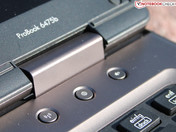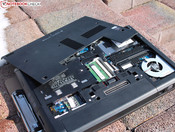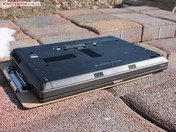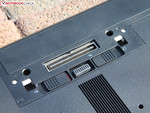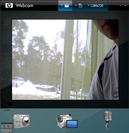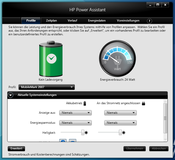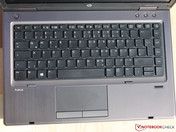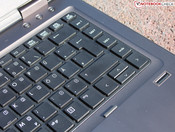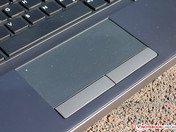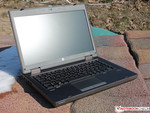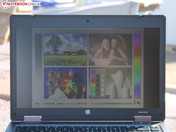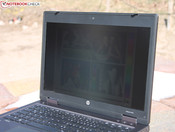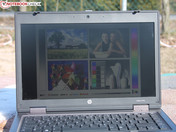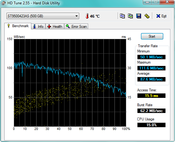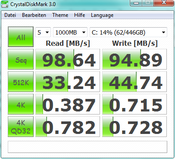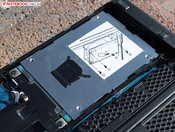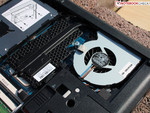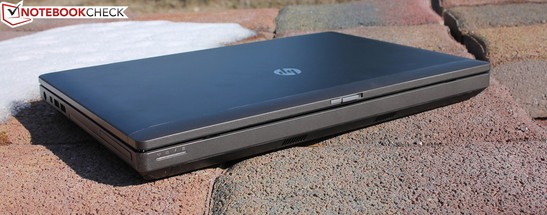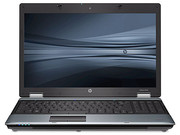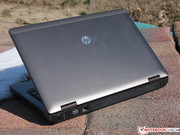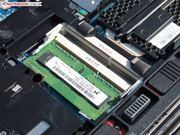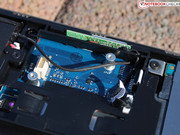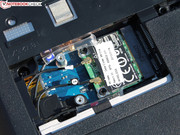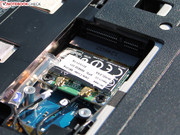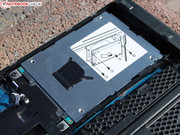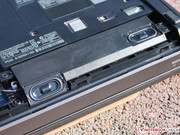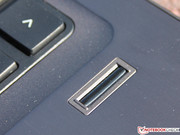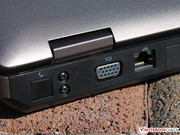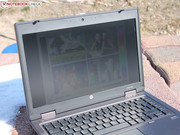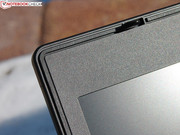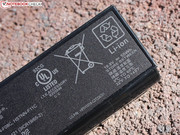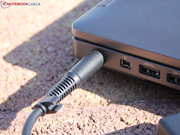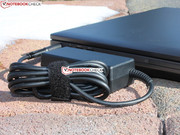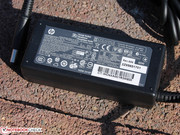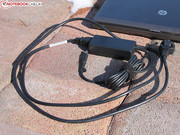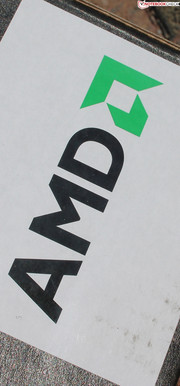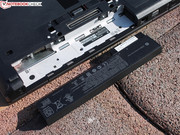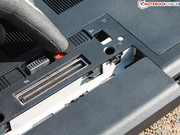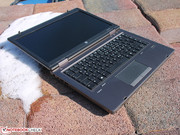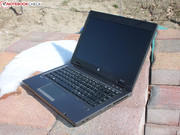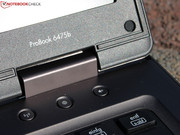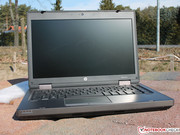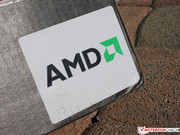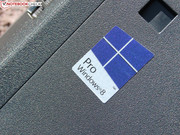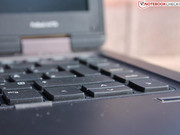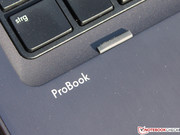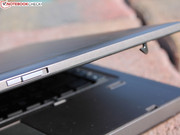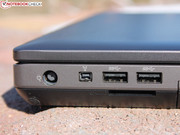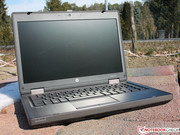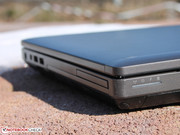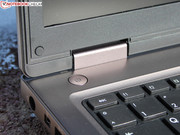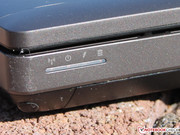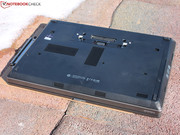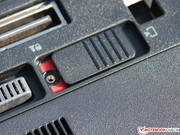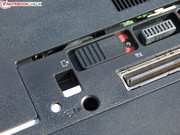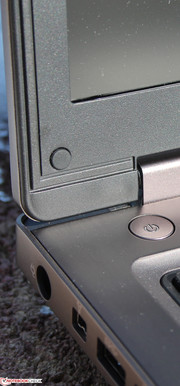Review HP ProBook 6475b Notebook

For the original German review, see here.
The Dell Vostro, Fujitsu's S/E series, Lenovo's ThinkPad L series (L530), Asus' Pro B series and Acer's TravelMate P models as well as HP's ProBook have something in common: All of them are aimed at business customers or private users who look for a workhorse device, people who don't want to spend more than $800-1000, but at the same time don't want to miss out on essential business features such as - at least - a typing-friendly keyboard, a matte display, a multitude of ports and a stable, non-glossy case suitable for everyday use.
With its 14-inch ProBook 6475b (model C5A55EA) equipped with an AMD A6-4400M and a WXGA++ panel, HP complements its series of 13-inch (6360b), 14-inch (6470b), 15-inch (4540s, 4535s) and 17-inch (4740s) notebooks which we have already reviewed. The 6475b is a direct sibling of the Intel-based 6470b with which it shares the same barebone. Like all ProBooks, the 6475b is available in a variety (9) of configurations ranging from $800 to $1000.
We are comparing the 6475b with three of its competitors which are also aimed at business users and demanding consumers, namely the Dell Vostro 3460, Lenovo's ThinkPad L430 and Acer's TravelMate P643. Of course, these are but a small selection of all comparable laptops, as can be seen in the corresponding list below this review - which does not even include cheaper office devices with worse build quality, less ports or unsatisfying input devices. But first let's have a closer look at the 6475b.
As already mentioned, the 6475b shares a common barebone with its Intel sibling, the 6470b. Number and type of ports are the same, as are their locations. Even the interior of the device looks alike, which makes maintenance of its components a breeze.
However, the 6475b differs considerably from the larger 15-inch 6570b, which sports a completely different chassis with different port locations and an additional numpad which the 6475b does not have. Only color, material and general shape and design remain similar.
HP has chosen to simply reuse the case of the 14-inch predecessor ProBook 6465b (early 2012) - apparently, its stable, high-quality build didn't require any improvements. For a more detailed analysis of all ports, we refer to our reviews of the ProBook 6465b (AMD) and the 6470b (Intel).
The ProBook 6475b offers all the numerous connections which more demanding users have come to expect. Since the lid is attached in the conventional way, some ports are even located on the back side of the laptop. Here, one can find both the Ethernet and VGA ports. The power adapter is straight and rigid, thus making it bulkier than necessary (but this is typical for HP). One advantage of the back side ports: The sides show less clutter. We are also quite fond of the concentration of ports near the rear end of the laptop.
Like its predecessor, the right side of the P6475b offers a DisplayPort replacing the older HDMI port. With a DisplayPort cable, external screen resolutions of up to 2560x1600 pixels are possible. Nostalgia sets in when we discover the old ExpressCard54 slot next to it. Both standard interface cards and ExpressCard34 cards fit here, rendering the 15.6-inch laptop expandable.
FireWire (i.LINK) might be of more interest in typical usage scenarios. FireWire used to be a USB 2.0 competitor for external hard drives (also eSATA) and camcorders, offering higher data transfer rates. It was rendered obsolete by USB 3.0 (the ProBook 6475b has two ports), but it might be a nice extra for users with older peripheral devices.
Communication
All P6475b variants offer Wi-Fi draft-n, but some come equipped with pretty much every possible radio device. There is a Broadcom module for Bluetooth 4.0 support, while the Realtek LAN adapter runs with full gigabit speed. Our model does not include an HSDPA modem (3G), although other variants do. In our test device, a free mini-PCI-Express slot with preinstalled antennas, as well as SIM card slot in the battery compartment, heavily imply a 3G version as well. An HP Connection Manager allows for different, location-sensitive Wi-Fi and Bluetooth profiles to be put in place.
Reception is excellent, not only three meters away from the router, but also in the first floor (10 m distance) and outside (15 m). It takes 40 meters for the signal quality to drop down to two bars, which is still satisfying. Even then, the connection remains uninterrupted. These values are astonishing, even more so considering that our router (Fritz!Box 7270) was set at 50% transmission power. Among the last ten devices this reviewer tested, only one - the Fujitsu Lifebook P702 with an Intel Centrino Advanced-N 6205 - was equally good concerning reception.
Security
It is possible to insert an optional SmartCard reader into the ExpressCard54 slot. SmartCards see some usage in corporate environments to allow for personalized logins. BIOS access can be locked with a password and a passive TPM 1.2 Embedded Security Chip for business usage is installed, allowing for unambiguous identification of a computer via a cryptographic key code. The keyboard is splash-proof and comes equipped with a drain in the bottom panel. All security solutions are bundled in the HP ProtectTools Security Manager.
Accessories
The HP 6475b wouldn't be a real business laptop without a matching docking solution. Both the HP 230W and the 90W docking stations (which cost around $180 and $160 respectively) fit, expanding the HP ProBook with a serial, PS2, DVI and parallel port. The Advanced Docking Station (Upgrade Bay, eSATA) is also suitable for usage with the 6475b. It costs around $280. All docking stations offer their own power supply, thereby also recharging the laptop.
The bottom panel also sports a battery port, where the travel battery pack (73 Wh, $80) can be attached as a slice beneath the base unit. This might be a recommendable addition to the P6475b, since its battery life of 4 hours (Wi-Fi usage) is rather fair to middling.
A Windows 8 Pro Recovery DVD is enclosed. This is not the case for Windows 7 Pro - with which the P6475b ships - as only a recovery partition exists. The HP laptop comes with few manuals: A Windows 8 installation guide and a setup booklet, that's it.
Maintenance
Maintenance is a breeze; the bottom panel can easily be removed by activating a simple slider mechanism. Afterwards, all internal components are accessible, including fans, CPU, RAM and the Mini PCI-Express ports (Wi-Fi, optional 3G modem). The Seagate HDD is a standard 9.5mm specimen so that all common 2.5-inch SATA SSDs and HDDs can be installed.
Warranty
HP offers 12 months of warranty for its ProBooks, however, in some countries, the laptop has to be sent in. This warranty can be extended to cover up to 3 years next-workday on-site service (Care Pack Services) for a hefty $300.
Despite its decent resolution (1280x720 pixels), the HD webcam suffers from bad image quality due to pale colors and a hit-and-miss autofocus. The Power Assistant is meant for switching between different energy profiles for different application or usage scenarios, replacing the more tedious Windows energy modes.
Keyboard
The keys of the 6475b offer a well-defined pressure point, generous travel as well as firm feedback. Nothing wobbles or bends when pressure is applied. We have a sweet tooth for the arrow keys, which can be accessed well without looking, even though they are not separated from the rest of the keys.
Writing maniacs are going to appreciate the slightly conic shape of the keys which guide the fingers, caressing them haptically. The Return key is a bit on the narrow side due to the neighboring Page Up and Page Down keys, but this didn't diminish our typing experience - the full-sized right Shift key is much more important in our opinion. In addition to the standard keys, there are also hardware buttons for the radio modems, speakers and the browser, which complement the function keys perfectly while being easy to reach.
Touchpad
The touchpad is positioned in a small, edged depression. The Synaptics LuxPad V7.5 (110 mm diagonally) is quite sensitive even in its edge regions, while offering an enjoyably smooth gliding experience. There is both a vertical and a horizontal scroll bar - neither of which is marked on the touchpad. One-finger scrolling is deactivated in its delivery condition.
The mouse keys are made from hard rubber, rendering them slip-proof. Travel is extraordinarily large and the keys can easily be actuated. Their feedback is great, increasing productivity far more than the usual rigid, short-winded keys of almost all consumer laptops.
The Synaptics touchpad comes equipped with a small palm sensor, deactivating the touchpad while the keyboard is in use. Like in all consumer laptops nowadays, this touchpad is also multitouch-enabled, thus allowing for two-finger scrolling, pinching or twisting.
The WXGA++ display of our ProBook 6475b model offers a very decent resolution of 1600x900 pixels. It provides an alternative to the HD panels (1366x768) of some low-cost variants of the P6475. The LG panel (type LP140WD1-TLD2) is matte, so that no strong reflections occur.
The brightness of the TN panel depends on the availability of an external power supply, throttling down from 205 cd/m² to 136 cd/m² while running on battery power. Brightness homogeneity levels of 77% are also disappointing - most test devices exceed 80%. However, no halos could be discerned visually near the edges.
The 6475b offers a contrast ratio of 209:1 due to a black level of 0.95 cd/m² (measured in the center). This is not much, but sill typical for its class. The competition (Vostro 3460, ThinkPad L430 and TravelMate P643) ends up with similar ratios.
| |||||||||||||||||||||||||
Brightness Distribution: 77 %
Center on Battery: 136 cd/m²
Contrast: 209:1 (Black: 0.95 cd/m²)
55.7% AdobeRGB 1998 (Argyll 3D)
80.3% sRGB (Argyll 3D)
54.1% Display P3 (Argyll 3D)
"Color space" are two important words for digital artists and graphics designers which require good agreement between real-life colors and their digital substitutes. Like its competitors, the 6475b does not manage to fully cover the sRGB color space, let alone the AdobeRGB color space. However, even expensive business laptops have a hard time fulfilling these requirements, as the last two graphs show. Even Lenovo's X1 Carbon (sporting the same HD+ resolution) fails to render all of the sRGB color space, despite expanding it upwards.
Due to its matte display, outdoor usage seems viable, but the non-preventable dimming down to 136 cd/m² while on battery power destroys these hopes. Our test image below is barely visible in sunlight, even less so from the sides. The situation can be improved by plugging the laptop into an outlet, however, even then 205 cd/m² may not be enough for a pleasant day on the terrace. 250 cd/m² or more would be needed for acceptable outdoor usage.
Wide viewing angles are important, allowing the user to make out all the details on the display even from the sides or from above. Office notebooks often employ inexpensive TN panels, leading to limited viewing angles. The 6475b doesn't perform quite as bad as some of its competitors. Horizontally, the display begins to darken at around 40 degrees, while color distortions occur beyond 70 degrees.
Vertical deviations are less benign. Colors start to invert at approximately 15 degrees, text becomes unrecognizable at 25 degrees or less. The Vostro 3460, the ThinkPad L430 and the TravelMate P643 offer the same experience concerning vertical viewing angles, but they fare worse in the horizontal direction (image stability lasting to around 45 degrees).
In the case of its 6475b model, HP employs the AMD Trinity platform (Intel is used in the 6470b). Only one of the variants, the A3Z20AV, sports an A8-4500M quad-core processor (4 x 1.9 GHz, accompanied by a Radeon HD 7640G, but without a Windows 8 license), while the other variants - one of them being our test version - come equipped with a dual-core AMD A6-4400M processor (2 x 2.7 GHz).
Only one of the two memory banks is occupied by a single 4 GB RAM module. Since Windows 7 Pro (32-bit) came preinstalled, all tests have been performed under Windows 7, despite the 6475b being shipped with a Windows 8 DVD. The graphics board of our test device is an integrated HD 7520G which snaps off 512 MB RAM.
Processor
Cinebench 11.5 does not work in a 32-bit environment, which is why we had to use the 32-bit version of the R10 Multi benchmark. Typical business laptops are equipped with an Intel Core i3 (+ 80-90%) or an i5 (+ 160-190%), rendering them much more potent than AMD's dual-core processor. Even the A8-4500M variant cannot compete with Intel's Core i platform, outperforming the A6-4400M by only 30% (this being an average taken over five test devices).
According to its fact sheet, the CPU clock speed varies between 2.7 and 3.2 GHz due to its turbo core. However, even under full load we measure only a value swaying between 2.4 and 2.9 GHz - for both cores. The clock speed decreases whenever the GPU is needed, as can also be seen in our high-temperature stress test evaluation.
Redeployment of resources is a fundamental principle of Accelerated Processing Units (APUs), distributing and allotting energy input variably between the CPU and GPU. While the Intel Core platform is capable of exhausting the maximum performance levels of both units at the same time, this cannot be done with the A6 or the A8. Only while operating on battery can the AMD APU use both CPU and GPU to the fullest (When 'Maximize Power' is chosen in the PowerPlay Battery settings), yielding similar Cinebench and 3DMark 11 scores as before.
| Cinebench R10 - Rendering Multiple CPUs 32Bit (sort by value) | |
| HP ProBook 6475b | |
| Fujitsu Lifebook S752 | |
| Asus B43E-VO158X | |
| Dell Vostro 3460 | |
| Asus Pro B43V-CU024X | |
| Lenovo ThinkPad L430 | |
| Dell Latitude E5430 | |
System Performance
PC Mark 7 yields a score of 1615 points. That's considerably less than the Core i5 competitors, the Vostro 3460, the ThinkPad L430 and the TravelMate P643. The Vostro 3460 fares best, both due to its fast GT 630M graphics board and its HDD cache, resulting in a high storage score. The P643's GT 640M GPU is even better, but it gets slowed down by its weak HDD performance. The HP ProBook 6475b's HDD scores in PCMark 7 and Vantage are actually quite okay for a 7200 rpm-HDD, but that is not enough to make up for its weaker CPU when compared to the Intel systems.
Core i3 systems like the Fujitsu S752 (HD 3000) are approximately on par with and possibly slightly superior to the 6475b. An SSD would be capable of boosting both synthetic and real-life performance considerably, as had been shown with our ProBook 6465b test device in 2012 (PCMark 7: 2420 points, Samsung SSD 470). Without an SSD, system boot times are mediocre (70 seconds until everything has been loaded) and programs may take a few extra seconds to start. This suffices for simple office applications, but Intel might be a more future-proof alternative: The ProBook 6470b sibling (our test device had a Core i5) managed to achieve 7256 points in the PCMark Vantage benchmark (instead of 4194 for the 6475b).
| PCMark Vantage Result | 4194 points | |
| PCMark 7 Score | 1615 points | |
Help | ||
Storage Devices
Data transfer rates are just average in both HD Tune and Crystal Disk Mark, with 87 MB/s and 100 MB/s read speed respectively. Nowadays, little difference is left between 5400 rpm and 7200 rpm HDDs. 4K-test results are far worse with 0.4 to 0.8 MB/s compared with up to 20 MB/s for SSDs, but HDDs are at a natural disadvantage when it comes to reading small scattered files as they have to move their reading heads into position first. Accordingly, the Vostro 3460 manages to achieve a 19 MB/s 4K read score due to its SSD cache, although this is a partially artificial result since it only takes into account accessing the small cache storage.
Graphics Card
The HD 7520G branches off up to 512 MB of main memory and boasts higher clock speeds than the HD 7640G of the A8-4500M (the AMD quad-core alternative to the 6475b) while settling with only 192 shader core units (the HD 7640G comes with 256), thus having to content itself with slightly worse benchmark results. The HD 7520G profits from dual channel memory, however, only one memory bank is in use in the 6475b. Still, it was never meant to power PC games or to conduct demanding encoding tasks. Its strengths lie with its low power consumption in idle mode (especially when the laptop is running on battery) and as an aide in decoding (Video Encoder) to the under-performing Piledriver core. More information can be found on the GPU data sheet.
The Radeon graphics card of the 6475b barely manages to squeeze ahead of the Intel HD 4000 in terms of processing power as our 3D Mark 11 figure shows. It doesn't stand a chance in both the brand-new 3DMark Cloud Gate (HD 4000: +59%; Vaio SV-E14 i3 3120M) and the Fire Strike benchmark (HD 4000: +36%) though.
Performance of the Radeon HD 7520G might increase by around 15% (empirical value) if a second RAM module was installed, making use of its dual channel mode. Even then, dedicated cards would still be uncatchable, as the 3DMark 11 performance of the GT 620M (S430), the NVS 5200M (B43V) and the GT 630M (Vostro 3460) can be up to twice as good. Of these three, only the Asus laptop sports an actual "business GPU". Still, the CAD/CAM-optimized drivers of the NVS 5200M will be probably be irrelevant for most users, making it a no better choice than its GeForce counterparts.
| 3DMark 06 Standard Score | 3832 points | |
| 3DMark Vantage P Result | 2011 points | |
| 3DMark 11 Performance | 608 points | |
| 3DMark Ice Storm Standard Score | 24204 points | |
| 3DMark Cloud Gate Standard Score | 2148 points | |
Help | ||
| 3DMark 11 - 1280x720 Performance (sort by value) | |
| HP ProBook 6475b | |
| Lenovo ThinkPad L430 | |
| Dell Latitude E5430 | |
| Lenovo ThinkPad Edge S430 | |
| Asus Pro B43V-CU024X | |
| Dell Vostro 3460 | |
Gaming Performance
The integrated GPU has not been designed with modern games in mind, which may even become apparent for office users during occasional gaming sessions. The only exceptions are undemanding games such as FIFA 13, which actually runs smoothly in HD. The data sheet of the HD 7520G provides an elaborate list of games and their performance. Obviously, modern PC games are a no-go. This holds true not only in the case of 3D shooter games like Crysis 3 and MoH: Warfighter, but also for Sim City (2013 version). Performance of an HD 4000 in combination with a Core i3 (ProBook 4340s) is marginally better, sometimes even worse (FIFA 13). Similar considerations apply in case of the HD 3000.
| HP ProBook 6475b Radeon HD 7520G, A6-4400M, Seagate Momentus 7200.4 ST9500423AS | Asus B43E-VO158X HD Graphics 3000, 2350M, Seagate Momentus 5400.6 ST9500325AS | HP ProBook 4340s H4R47EA HD Graphics 4000, 3120M, Hitachi Travelstar Z5K500 HTS545050A7E380 | |
|---|---|---|---|
| SimCity | |||
| 1024x768 Low (fps) | 19 | 21 11% | |
| Fifa 13 | |||
| 1366x768 High AA:2xMS (fps) | 42 | 30 -29% | 33 -21% |
| Mass Effect 3 | |||
| 1280x720 all off (fps) | 21 | 21.4 2% | |
| Medal of Honor: Warfighter | |||
| 1024x768 Low Preset AF:2x (fps) | 19 | 19 0% | |
| Total Average (Program / Settings) | -14% /
-14% | -3% /
-3% |
| low | med. | high | ultra | |
|---|---|---|---|---|
| Mass Effect 3 (2012) | 21 | |||
| Fifa 13 (2012) | 65 | 49 | 42 | |
| Medal of Honor: Warfighter (2012) | 19 | 13 | ||
| Dead Space 3 (2013) | 44 | 23 | 18 | |
| Crysis 3 (2013) | 14 | 9 | 5 | |
| SimCity (2013) | 19 | 12 | 9 |
System Noise
Noise is no issue with the ProBook 6475b - at least, if the user chooses to deactivate the BIOS option "Fan always on when AC". In that case, the fan remains silent when the laptop is left (mostly) idle, being used only for office tasks and some light browsing. Some ambient noise exists due to the 7200 rpm HDD, which causes a minimal sound pressure of 32.6 dB(A).
Even when the fan is spinning slowly, the HDD remains the loudest component. At least, no disturbing vibrations occurred - a problem earlier ProBook models encountered. The read-write heads are quieter than the HDD rotation, so that general noise levels remain rather constant. Even the radiator, which is sometimes active for approximately 30 to 60 seconds, doesn't surpass 33 dB(A).
Under full load, 36.6 to 39.7 dB(A) was measured. At least the upper limit will hardly ever be reached in normal office use as it was derived in our stress test (see below), which lacks in practical relevance. Three of the 6475b's competitors - the Vostro 3460, the TravelMate P643 and the Asus Pro B43V - are louder due to their dedicated GPUs, at least under full load (up to 46 dB(A)). Both the ThinkPad L430 (HD 4000) and the Edge S430 (GT 620M) fare better in this regard (35 and 33 dB(A)).
Noise level
| Idle |
| 32.6 / 32.6 / 32.8 dB(A) |
| HDD |
| 32.9 dB(A) |
| DVD |
| 38.7 / dB(A) |
| Load |
| 36.6 / 39.7 dB(A) |
 | ||
30 dB silent 40 dB(A) audible 50 dB(A) loud |
||
min: | ||
Temperature
When idle, the underbelly of the 6475b remains fairly cool with an average of 34 °C, although some parts of the bottom panel can get as warm as 38 °C (most likely because of the deactivated fan, since these parts actually get cooler under full load when the fan spins up). Palm rest temperatures are more pleasant still, reaching approximately 30 °C.
We appreciate that both the palm rest and the keys themselves remain rather cool, with the latter becoming lukewarm at best, while the former remain cool (up to 32 °C) even under full load. Temperatures underneath the laptop don't exceed 41 °C (this maximum value is reached above the fan during our stress test) while their average only increases by 1 °C when compared to the idle state. When no demanding tasks are active, all the waste heat gets distributed rather evenly across the case, but during the stress test, the 6475b's heatpipe (recuperator) concentrates all of it at one point, which is exactly where we measure this maximum of 41 °C.
As we have mentioned in the Performance section, the stress test - where both Furmark and Prime95 are active at the same time - leads to a redistribution of computational power between the CPU and the GPU, with the graphics card running at full power (685 MHz, maximum turbo), while the CPU is throttled down to 910 MHz on a single core.
(+) The maximum temperature on the upper side is 34.8 °C / 95 F, compared to the average of 34.3 °C / 94 F, ranging from 21.2 to 62.5 °C for the class Office.
(±) The bottom heats up to a maximum of 41.3 °C / 106 F, compared to the average of 36.8 °C / 98 F
(+) In idle usage, the average temperature for the upper side is 30.1 °C / 86 F, compared to the device average of 29.5 °C / 85 F.
(+) The palmrests and touchpad are reaching skin temperature as a maximum (32.7 °C / 90.9 F) and are therefore not hot.
(-) The average temperature of the palmrest area of similar devices was 27.6 °C / 81.7 F (-5.1 °C / -9.2 F).
Speakers
Both speakers are located beneath the laptop, in a box made out of plastic which has been integrated close to the user in the front. Basses are unconvincing and the chassis vibrates considerably, but at least distortions at full volume turn out to be minimal. Plus, the 6475b is as loud as office laptops go. It shouldn't be hard to fill an entire conference room with its sound.
Mids and highs were unbalanced. As with most laptops without a dedicated subwoofer or more powerful speakers in general, emphasis is put on the mids. Still, external speakers and microphones can always be plugged in via not one but two separate 3.5 mm ports, one for Line In, the other for Line Out. This could lead to a better audio quality than with the combined Line In/Out ports which are much more common in consumer notebooks. Unfortunately, the connections have not been reinforced with metal, making them more susceptible to breaking when used intensively.
Power Consumption
The HP ProBook 6475b is a rather power-hungry machine, as evidenced by a minimum power consumption of 10.5 watts (while idle, with an active energy saver profile and minimal luminance) which foreshadows no more than average battery life. Power consumption during idle mode tops out at 16.5 watts (high performance profile). The 6475b's Intel competitors prove to be more economical: 9 to 15 watts (Vostro 3460), 7 to 12.5 watts (ThinkPad L430) and 8 to 11 watts (TravelMate P643) respectively.
This situation reverses under full load. Power consumption increases when both CPU and GPU are working together (39 to 40 watts, 3DMark 06 & stress test), but still ends up being exceeded by its competitors, which require 64 to 66 watts (Vostro 3460), 36 to 48 watts (ThinkPad L430) and 58 to 60 watts (TravelMate P643) respectively. The difference stems from their dedicated GPUs.
The power adapter supplies 65 watts, which is adequate for the 6475b. Recharging the battery takes 1:50 h, an acceptable charging time.
| Off / Standby | |
| Idle | |
| Load |
|
Key:
min: | |
Battery Life
The 14-inch laptop sports a comparatively small 48 Wh battery. Its Intel competitors, the Vostro 3460 (48 Wh, 3:52 h during our Wi-Fi test), the ThinkPad L430 (57 Wh, 3:30 h) and the TravelMate P643 (66 Wh, 6:05 h) tend to boast higher capacities, which in combination with their low power consumption leads to better battery life when idle. During our Wi-Fi benchmark, our test device (which comes equipped with a 55 Wh battery) achieves 4:15 hours at 150 cd/m² brightness (actually, 136 cd/m²).
The Battery Eater Reader's Test (CPU and GPU are idle, all radio modems are deactivated and brightness is set as low as it gets) yields 9:01 hours. DVD playback lasts 3:54 hours, which is almost as good as during the Wi-Fi test because the DVD video test demands full display brightness, while the 6475b is incapable of going beyond 136 cd/m² as long as it is on battery. Our test device manages to squeeze 2:01 hours out of its battery under full load. Only one of its competitors surpasses the two-hour mark as well, the P643 (2:03 h due to its 66 Wh battery). A comparable 48 Wh battery in an Intel laptop only manages to reach 1:15 h (Vostro 3460).
HP (mostly) made the right choices with the ProBook 6475b, delivering a more or less balanced package of time-proven office features. We appreciate the excellent feedback its input devices (keys, touchpad) provide. Its conically curved keys come particularly close to the level of much more expensive laptops including the Dell Latitude, Lenovo ThinkPad (T and L) and HP EliteBook series.
Its understated look works very well with the matte aluminum touch to its surfaces. But the 6475b is not just all show and no substance. Connectivity is important to the ProBook, with options ranging from external docking stations, DisplayPort and VGA ports (for high-resolution as well as legacy displays) to an ExpressCard54 slot for old extension cards which are still being used for measuring devices by craftspeople and engineers. Traditionalists can rejoice: HP has chosen to install Windows 7 Pro (32 bit), although the 6475b ships with a Windows 8 DVD as well.
The HP ProBook is also very maintenance-friendly. Plus, there are many variants to choose from, including some with UMTS and/or an HD panel (if a lower resolution than HD+ is desired). There is no SSD option though - this has to be installed by the user.
Ergonomics in idle mode or under half load could have been better and although the fan can be deactivated through an option in the BIOS (turn "Fan always on when AC" off), the background noise the HDD produces can be heard at all times. Then again, excess heat is no issue - neither while idle nor under full load.
Despite of our praise for its well-balanced color rendition, the TN panel only manages to secure a score of 76%, since a typical user of the ProBook 6475b will most likely not be a professional digital artist or graphics designer so that an exact reproduction of real-life colors is not as crucial as it could be. The weaknesses of the display lie with its low contrast and terrible brightness, especially so when it is running on battery power: Maximum brightness gets throttled down to 137 cd/m². Outdoor usage becomes a pain. Hardly any screen contents at all can be read under direct sunlight.
Other laptops offer more in terms of processor, graphics card and memory for the same price point as our test device ($900), namely Core i5 CPUs with dedicated GPUs for an improved gaming performance. Great input devices, an optional docking station, a matte WXGA++ display and a superbly stable, well-built chassis are harder to find for less than $1000. Only variants of the Vostro 3460 or the ThinkPad L430 offer such amenities. The TravelMate P643, equipped with a gaming-friendly GT 640M, tempts with its great value-for-money ratio, while the best input devices and highest build quality can be found in one of the cheaper (HD panel) Latitude E5430 configurations.
We have written reviews of all of the following competitors to the 6475b and we recommend having a look at them before a purchase decision is made. If this takes too much time, it is also possible to just focus on the four models which are highlighted in bold.
- Dell Latitude E6430 (i3, HD 3000) $1050
- Dell Latitude E5430 (i3, HD 3000) $850
- Dell Vostro 3460 (i5, GT 630M, WXGA++) $850
- Asus Pro B43V-CU024X (i5, GT 630M, 128 GB SSD) $950
- Asus B43E-VO158X (i3, HD 3000) $750
- Acer TravelMate P643-MG-53214G75Mikk (i5, GT 640M) $900
- Fujitsu Lifebook S752 (i3, HD 3000) $850
- HP ProBook 6465b LY433EA (A6-3410MX, 128 GB SSD) $1100
- HP ProBook 6470b (i5, HD 4000) $1000
- Lenovo ThinkPad L430 (i5, HD 4000, WXGA++) $800
- Lenovo ThinkPad Edge S430 (i5, GT 620M, WXGA++) $850
- Toshiba Tecra R840-11E (i5, HD 3000) $1050





